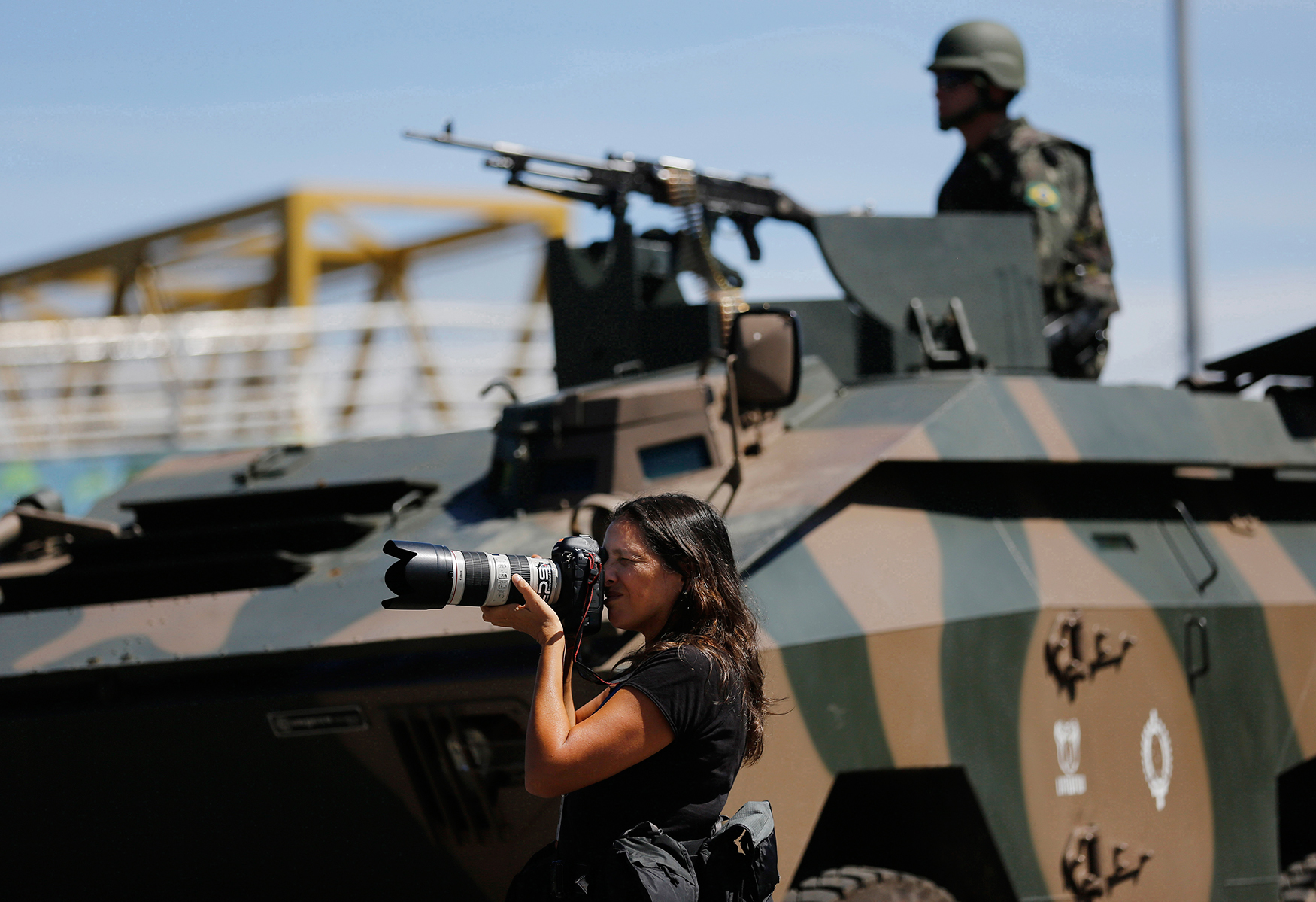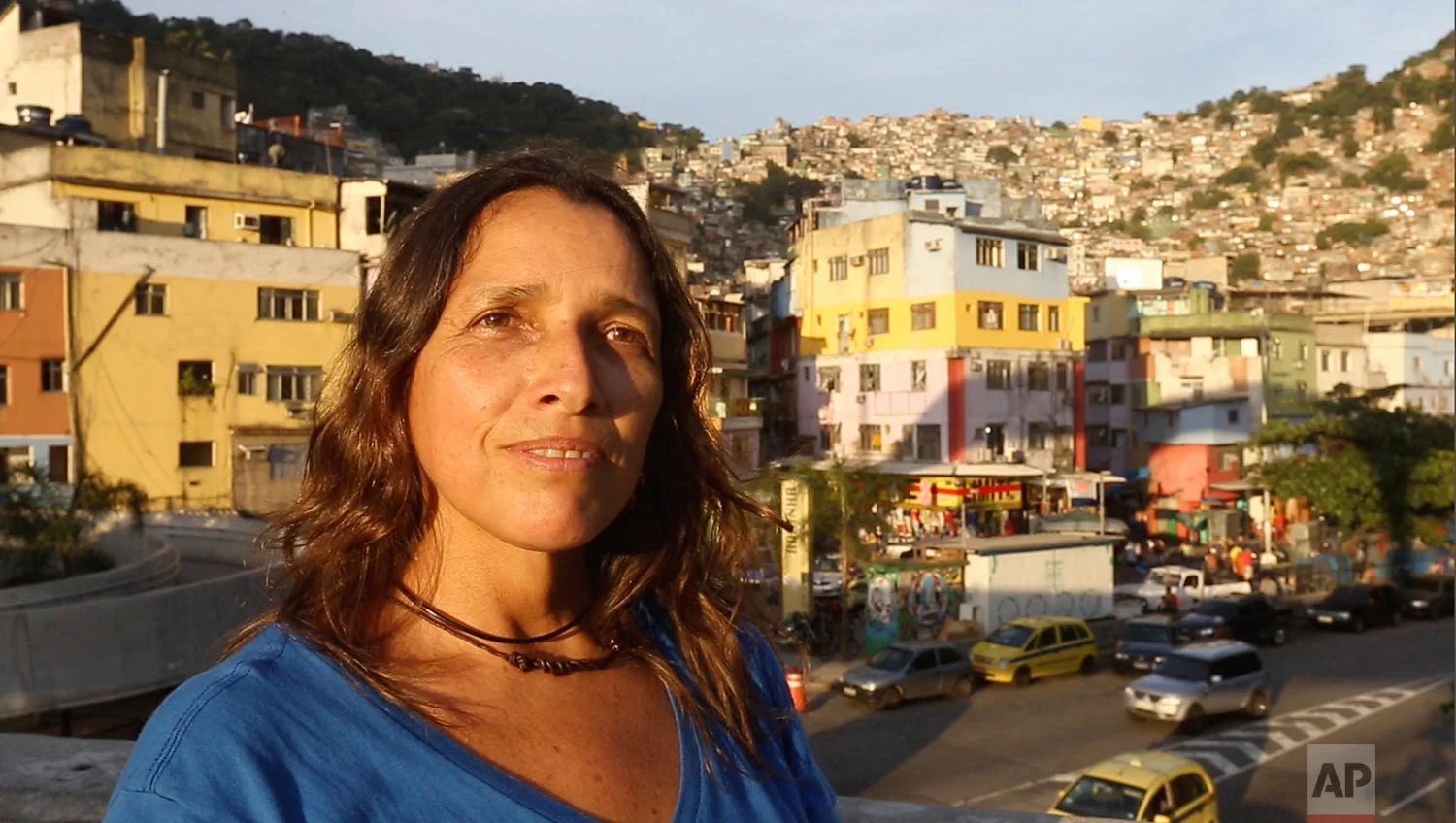AP photographer reflects on 13 years covering Rio shootings

It’s often said the birth of a child changes your life. Covering the shooting deaths of children in recent months amid a wave of violence in Rio de Janeiro, I have realized from the pain of grieving parents that losing one probably changes you even more.
In this April 26, 2017 photo, Michele de Oliveira grieves over the coffin containing the remains of her 13-year-old son Paulo Henrique Oliveira, in Rio de Janeiro, Brazil. Paulo lived with his family in the Alemao complex of slums and was walking to visit a neighbor when he was mortally wounded by a stray bullet from a shootout between police and drug traffickers. (AP Photo/Silvia Izquierdo)
I began working as a photographer in Rio de Janeiro in 2004, and since then I have covered numerous deadly shootings including many innocent people caught in the crossfire.
Sometimes it happens when heavily armed drug traffickers battle over turf. Other times gangs shoot it out with elite units of military police — more like commando squads than what usually comes to mind when people think of police.
For all its natural beauty, the “Marvelous City,” as Rio is called, has long struggled with violence. It seems to possess a toxic mix of deep social and racial inequalities, lots of guns, drugs and gangs, slums built helter-skelter on hillsides that are essentially impossible to patrol and brutal tactics by police, who themselves are often targeted and killed.
In this Aug. 21, 2017 photo, a soldier takes position during a security operation next to a wall spray painted with a message that reads in Portuguese: "Police die," in the Jacarezinho slum, in Rio de Janeiro, Brazil. Thousands of soldiers and police are occupying a series of slum communities in northern part of the city as part of efforts to combat a spike in violence. (AP Photo/Silvia Izquierdo)
Around 2008 I began noticing a drop in the shootings thanks to the implementation of Police Pacification Units, known by the Portuguese acronym UPP. Thousands of officers were stationed in many of the worst favelas, or slums, while the city coupled that enforcement with increased public services.
Brazil was booming economically, and the city had two global showcase events on the horizon that were incentives to make the program work: the 2014 World Cup in Brazil and the 2016 Rio Summer Olympics.
But the pacification program was clearly showing cracks before the Olympics as Brazil’s worst economic crisis in decades set in, combined with a bevy of multibillion-dollar corruption scandals that have left state coffers barren. Now, more than a year after the Games, it feels like a return to the savagery of the early 2000s.
In this April 5, 2017 photo, students practice taking cover during shootings between gangsters and police, in a classroom at the Uere Special Needs School, in the Mare slum in Rio de Janeiro, Brazil. With rival drug dealers on practically every corner and a militarized campaign by authorities to take them out, shootouts have become so common that the school holds drills for students to practice taking cover quickly. (AP Photo/Silvia Izquierdo)
For me the proof is in the heart-wrenching stories of kids killed in the crossfire. Authorities don’t specifically track how many of them die in shootings — they are lumped in with all homicides — so it’s impossible to say for sure whether violence is worse today than in years past. But in my 13 years in Rio, I don’t remember a time when there has been such a string of shocking and senseless cases of children dying.
They have been gunned down in restaurants, at their friends’ homes, at school, all manner of places where you’d think they would be safe.
In this May 24, 2017 photo, residents and activists march demanding an end to the gun battles between police and gangs that put residents in the crossfire, in the Mare complex of slums, in Rio de Janeiro, Brazil. With an average of 15 shootings a day, gunfire is often heard across the city that hosted the Summer Olympic Games just a year ago. (AP Photo/Silvia Izquierdo)
In a sense, it doesn’t matter whether it was a gang member or a cop who pulled the trigger. Young people like Sofia Lara, Fernanda, Maria Eduarda, Felipe, Arthur and Vanessa are gone, and their families are left to deal with emotions ranging from emptiness and rage.
I’ve seen parents nearly pass out at funerals, clinging to pictures of fallen children and breaking down at just the mention of their names. No matter how many times I cover these tragedies, I’ll never get used to it — and I never want to.
These parents should not have to be dying inside, because their kids should not be dying.
In this Nov. 28, 2010 photo, Zeu, an alleged drug trafficker, is detained during a police operation at the Alemao complex of slums, in Rio de Janeiro, Brazil. In late November 2010, security forces seized control of what many believe to be the city's most dangerous slum, claiming victory in the ongoing battle against drug gangs. The victory appears to have been temporary. (AP Photo/Silvia Izquierdo)
In this Oct. 10, 2016 photo, police escort men detained during an operation in the Pavao Pavaozinho slum in Rio de Janeiro, Brazil. An hours-long shootout between police and suspected criminals left three people dead, as well as blocking streets and closing shops in the posh Copacabana and Ipanema districts. The slum is entrenched between and overlooks the two fancy neighborhoods. (AP Photo/Silvia Izquierdo)
In this Nov. 27, 2010 photo, children cry during a shootout between police and drug traffickers in the Alemao complex of slums, in Rio de Janeiro, Brazil. Soldiers and police crouched behind armored vehicles trained their rifles on dozens of entrances to the complex where more than 85,000 people live, giving drug traffickers a chance to surrender before they stormed what is considered the most dangerous area of Rio. (AP Photo/ Silvia Izquierdo)
In this March 26, 2014 photo, an officer with the Special Police Operations Battalion takes position while residents run for cover during an operation in the Mare slum complex, ahead of its "pacification" security program, in Rio de Janeiro, Brazil. At the time the city had two global showcase events on the horizon that were incentives to make the program work: the 2014 World Cup in Brazil and the 2016 Rio Summer Olympics. (AP Photo/Silvia Izquierdo)
In this June 30, 2017 photo, children show spent bullet casings, backdropped by a blood-stained towel, after a shootout between police and drug traffickers at the Mangueira slum, in Rio de Janeiro, Brazil. The towel is stained with the blood of a 76-year-old woman and her daughter, both killed in the crossfire of a police operation. Marlene Maria da Conceicao was shot in the neck in the doorway of her home and her 42-year-old daughter, Ana Cristina was hit when she tried to help her mother. (AP Photo/Silvia Izquierdo)
In this Sept. 27, 2017 photo, girls walk past a wall riddled with bullet holes from shootings between rival drug traffickers, at the Rocinha slum, in Rio de Janeiro, Brazil. Violence is on the rise in Rio's slums after several years of decline, and the killings of kids have shocked even residents long inured to deaths from gangs and police. (AP Photo/Silvia Izquierdo)
In this July 6, 2017 photo, friends and relatives jeer at police officers, who they blame for the death of a 10-year-old girl, during a demonstration protesting another death of a child by a stray bullet, in the Lins complex of slums, Rio de Janeiro, Brazil. The manifestation followed the burial of Vanessa do Santos earlier in the day. She was killed two days earlier at her home after being hit in the head by a bullet fired during a police operation in the slum complex. (AP Photo/Silvia Izquierdo)
In this Aug. 21, 2017 photo, a soldier pats down a woman as a girl waits during a security operation at the Jacarezinho slum, in Rio de Janeiro, Brazil. In July the federal government deployed over 8,500 troops to try to stamp out crime in Rio's roughest neighborhoods. But so far they have not been able to stem the bloodshed. (AP Photo/Silvia Izquierdo)
Silvia Izquierdo is The Associated Press Chief Photographer for Brazil. She is currently based in Rio de Janeiro.
Text from the AP news story, AP photographer reflects on 13 years covering Rio shootings, by Silvia Izquierdo.
Photos by Silvia Izquierdo






